Abstract
Five asthmatic patients aged 25-30 years were studied during and after 6-8 minutes of steady exercise on both a bicycle ergometer and a treadmill. For each patient the duration of work, oxygen consumption, minute ventilation, and heart rate were similar in each form of exercise.
During exercise all patients had an increase in peak expiratory flow rate. The blood lactate level was higher during bicycle exercise but arterial Pco2 and pH fell to similar levels during both forms of exercise. There was a rise in arterial oxygen tension in four of the patients during exercise; in one subject arterial oxygen tension fell.
Bronchoconstriction was greater following treadmill exercise in all subjects and was associated with an increase in ventilation/perfusion inequality, as shown by arterial hypoxaemia, an increase in alveolar-arterial oxygen tension gradients, and an increase in physiological dead space. In one subject whose PEFR fell to 25% of the predicted value Co2 retention occurred. These changes are similar to those found in other forms of acute asthma.
In one subject, during both forms of exercise the mixed expired Pco2 was observed to be higher than the arterial Pco2, thus giving a negative value for physiological dead space. This observation is discussed.
Full text
PDF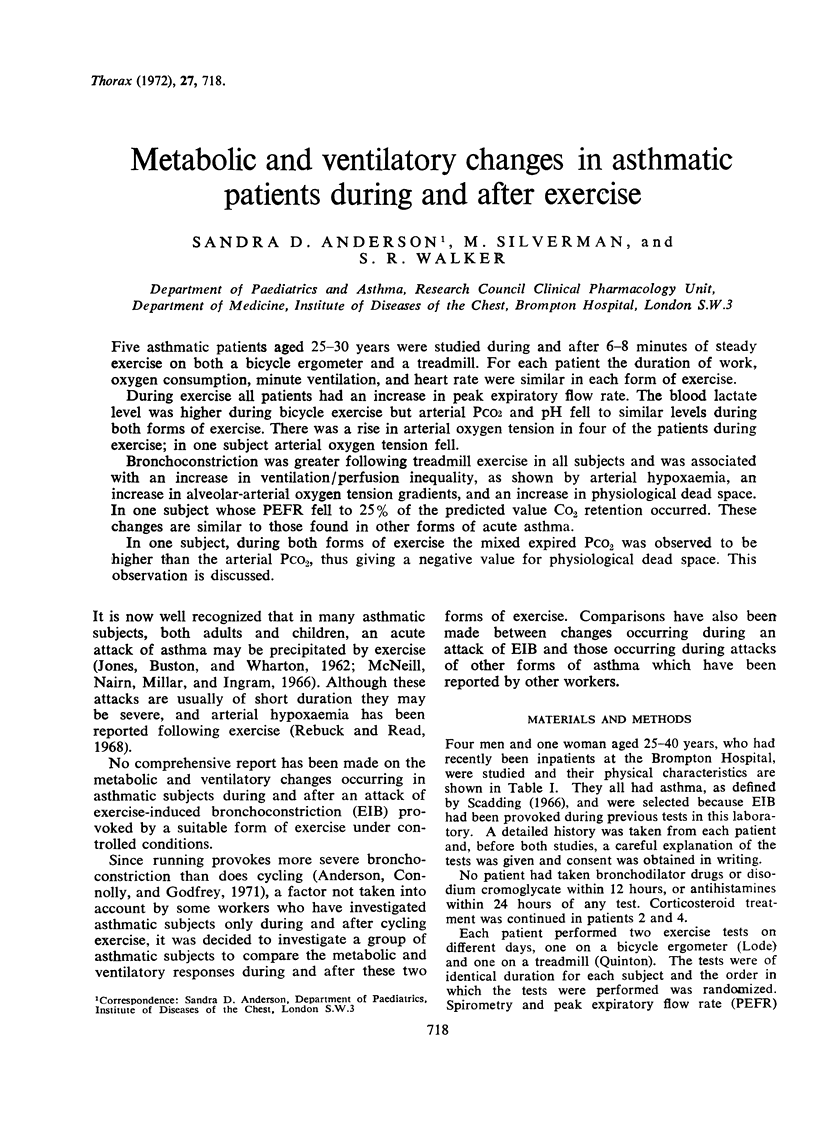
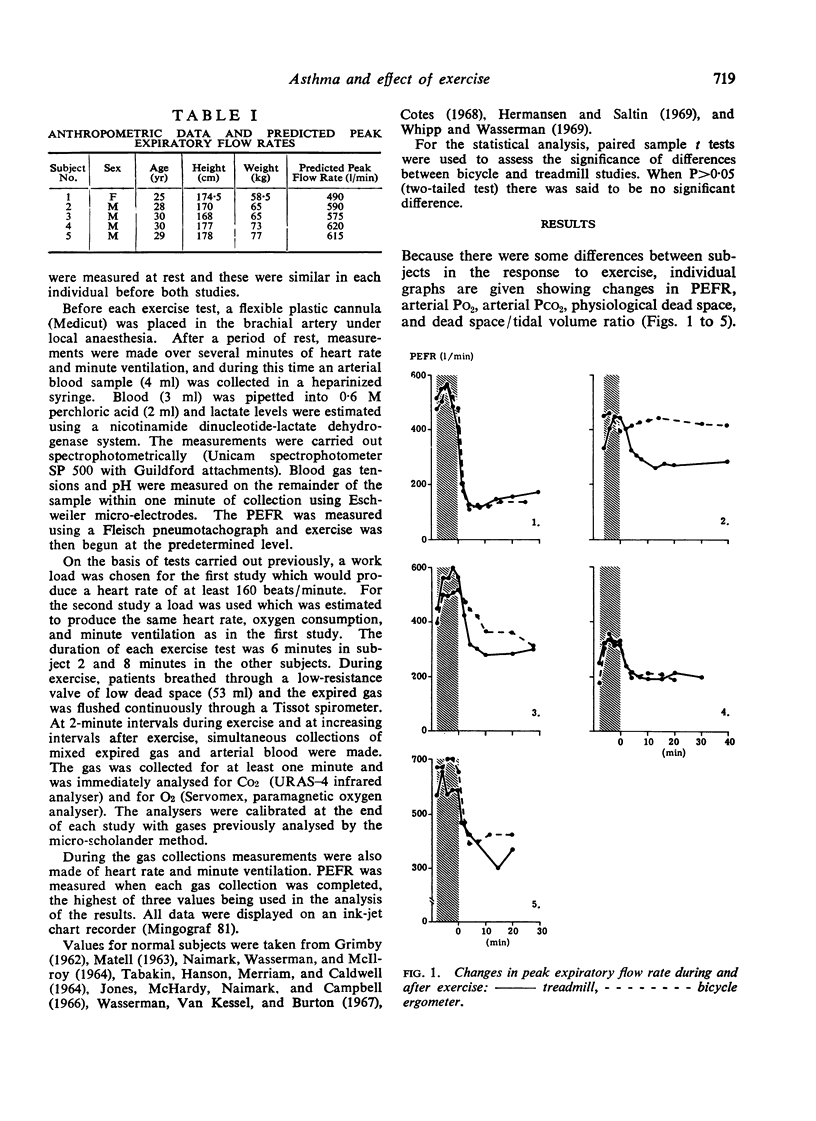
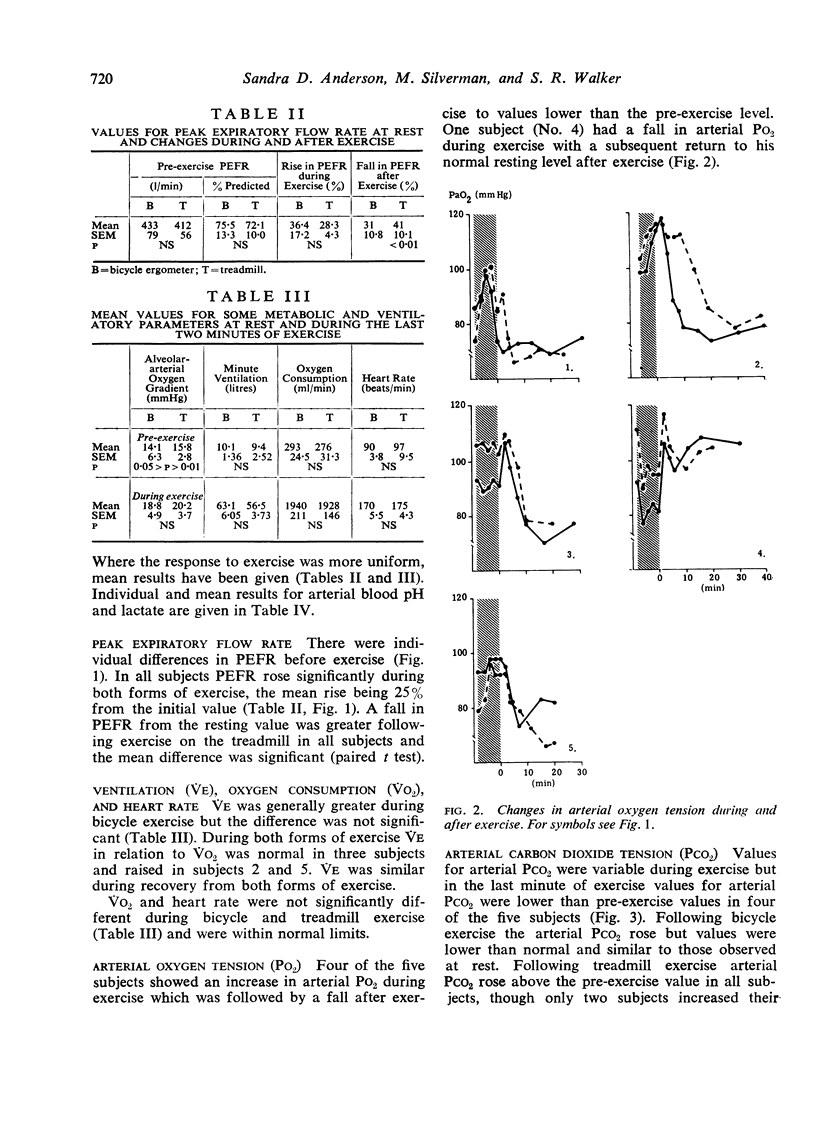
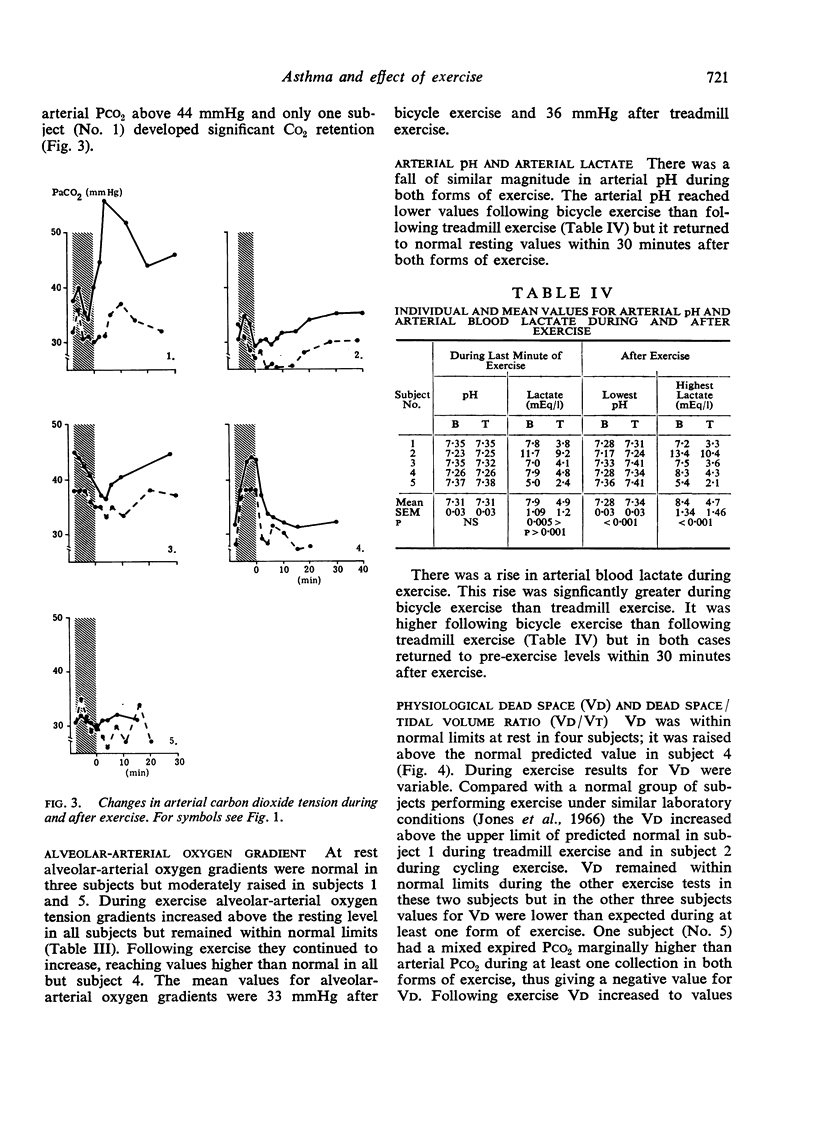
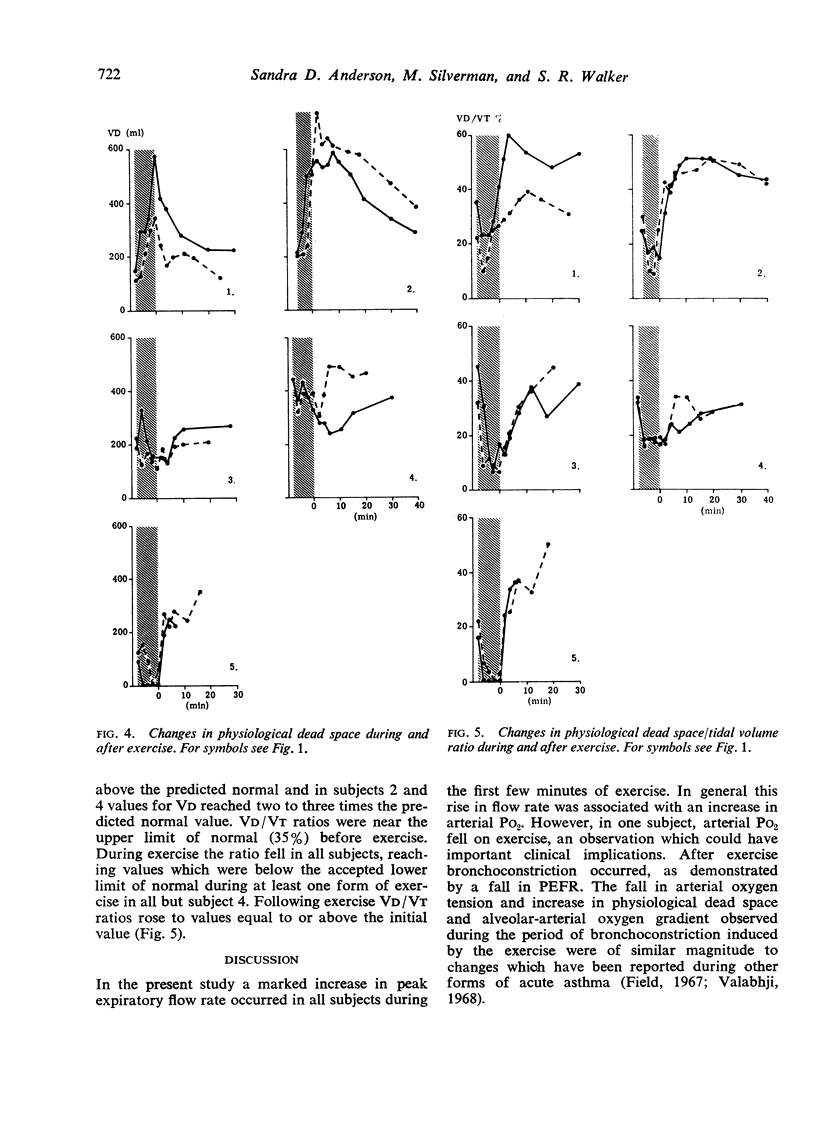
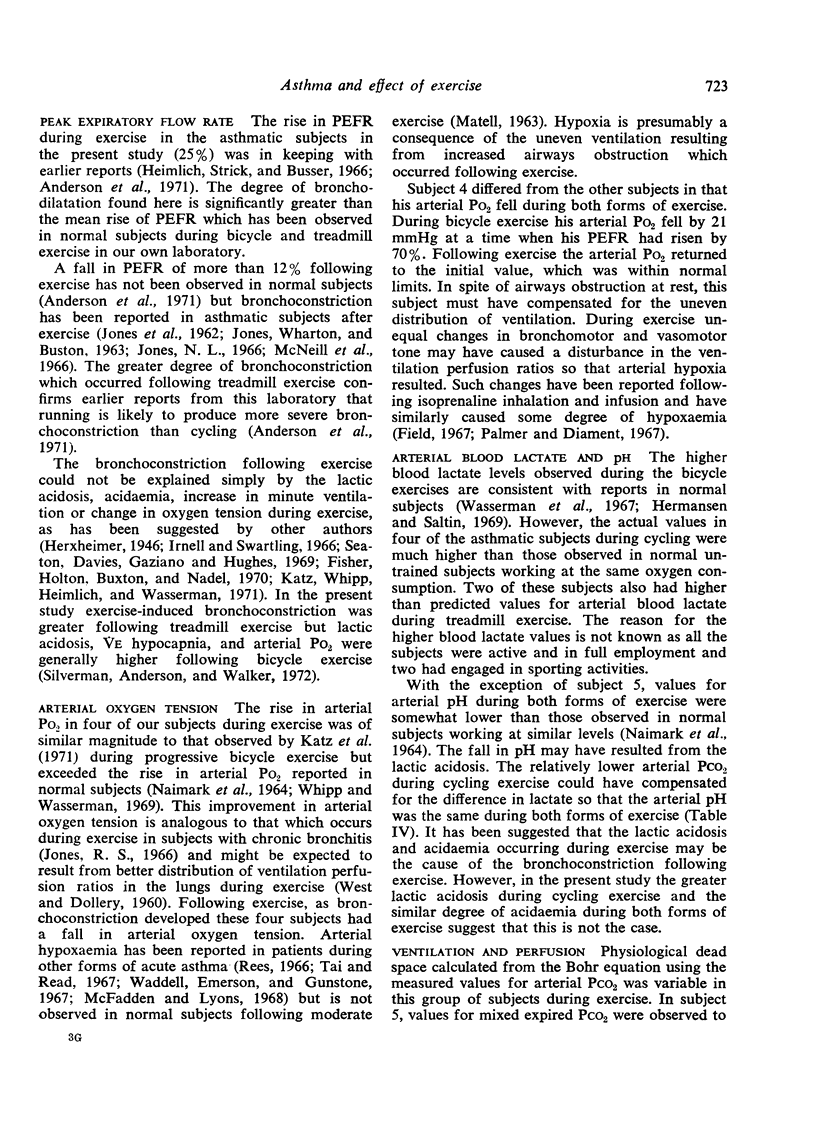
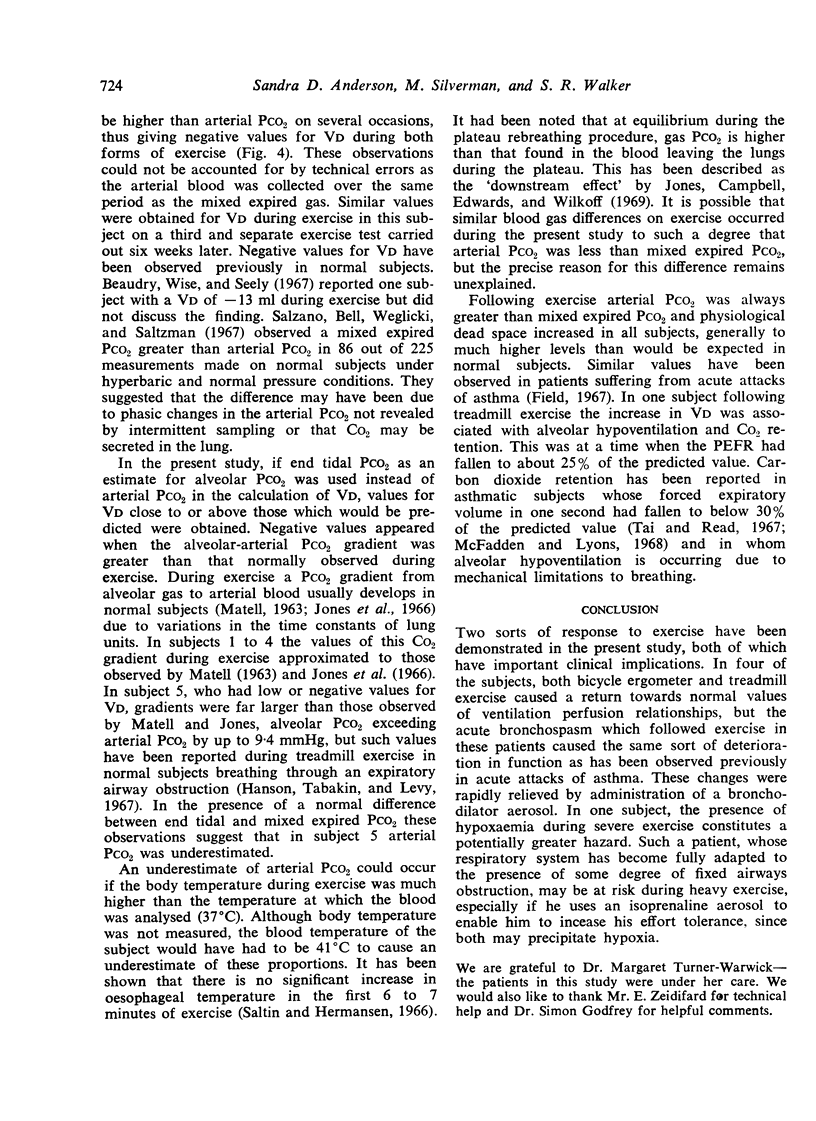

Selected References
These references are in PubMed. This may not be the complete list of references from this article.
- Anderson S. D., Connolly N. M., Godfrey S. Comparison of bronchoconstriction induced by cycling and running. Thorax. 1971 Jul;26(4):396–401. doi: 10.1136/thx.26.4.396. [DOI] [PMC free article] [PubMed] [Google Scholar]
- Beaudry P. H., Wise M. B., Seely J. E. Respiratory gas exchange at rest and during exercise in normal and asthmatic children. Am Rev Respir Dis. 1967 Feb;95(2):248–254. doi: 10.1164/arrd.1967.95.2.248. [DOI] [PubMed] [Google Scholar]
- Field G. B. The effects of posture, oxygen, isoproterenol and atropine on ventilation-perfusion relationships in the lung in asthma. Clin Sci. 1967 Apr;32(2):279–288. [PubMed] [Google Scholar]
- Fisher H. K., Holton P., Buxton R. S., Nadel J. A. Resistance to breathing during exercise-induced asthma attacks. Am Rev Respir Dis. 1970 Jun;101(6):885–896. doi: 10.1164/arrd.1970.101.6.885. [DOI] [PubMed] [Google Scholar]
- GRIMBY G. Exercise in man during pyrogen-induced fever. Scand J Clin Lab Invest. 1962;14 (Suppl 67):1–112. [PubMed] [Google Scholar]
- Hanson J. S., Tabakin B. S., Levy A. M. Exercise arterial blood gas and end-tidal gas changes during acute airway obstruction. Respir Physiol. 1967 Aug;3(1):64–77. doi: 10.1016/0034-5687(67)90025-4. [DOI] [PubMed] [Google Scholar]
- Hermansen L., Saltin B. Oxygen uptake during maximal treadmill and bicycle exercise. J Appl Physiol. 1969 Jan;26(1):31–37. doi: 10.1152/jappl.1969.26.1.31. [DOI] [PubMed] [Google Scholar]
- Herxheimer H. Skin sensitivity to flour in bakers' apprentices. Lancet. 1967 Jan 14;1(7481):83–84. doi: 10.1016/s0140-6736(67)92479-8. [DOI] [PubMed] [Google Scholar]
- Irnell L., Swartling S. Maximal expiratory flow at rest and during muscular work in patients with bronchial asthma. Scand J Respir Dis. 1966;47(2):103–113. [PubMed] [Google Scholar]
- JONES R. S., WHARTON M. J., BUSTON M. H. THE PLACE OF PHYSICAL EXERCISE AND BRONCHODILATOR DRUGS IN THE ASSESSMENT OF THE ASTHMATIC CHILD. Arch Dis Child. 1963 Dec;38:539–545. doi: 10.1136/adc.38.202.539. [DOI] [PMC free article] [PubMed] [Google Scholar]
- Jones N. L., Campbell E. J., Edwards R. H., Wilkoff W. G. Alveolar-to-blood PCO2 difference during rebreathing in exercise. J Appl Physiol. 1969 Sep;27(3):356–360. doi: 10.1152/jappl.1969.27.3.356. [DOI] [PubMed] [Google Scholar]
- Jones N. L. Pulmonary gas exchange during exercise in patients with chronic airway obstruction. Clin Sci. 1966 Aug;31(1):39–50. [PubMed] [Google Scholar]
- Jones R. S. Assessment of respiratory function in the asthmatic child. Br Med J. 1966 Oct 22;2(5520):972–975. doi: 10.1136/bmj.2.5520.972. [DOI] [PMC free article] [PubMed] [Google Scholar]
- Katz R. M., Whipp B. J., Heimlich E. M., Wasserman K. Exercise-induced bronchospasm, ventilation, and blood gases in asthmatic children. J Allergy. 1971 Mar;47(3):148–158. doi: 10.1016/s0091-6749(71)80293-2. [DOI] [PubMed] [Google Scholar]
- McFadden E. R., Jr, Lyons H. A. Arterial-blood gas tension in asthma. N Engl J Med. 1968 May 9;278(19):1027–1032. doi: 10.1056/NEJM196805092781901. [DOI] [PubMed] [Google Scholar]
- McNeill R. S., Nairn J. R., Millar J. S., Ingram C. G. Exercise-induced asthma. Q J Med. 1966 Jan;35(137):55–67. [PubMed] [Google Scholar]
- NAIMARK A., WASSERMAN K., MCILROY M. B. CONTINUOUS MEASUREMENT OF VENTILATORY EXCHANGE RATIO DURING EXERCISE. J Appl Physiol. 1964 Jul;19:644–652. doi: 10.1152/jappl.1964.19.4.644. [DOI] [PubMed] [Google Scholar]
- Palmer K. N., Diament M. L. Effect of aerosol isoprenaline on blood-gas tensions in severe bronchial asthma. Lancet. 1967 Dec 9;2(7528):1232–1233. doi: 10.1016/s0140-6736(67)90567-3. [DOI] [PubMed] [Google Scholar]
- Rebuck A. S., Read J. Exercise-induced asthma. Lancet. 1968 Aug 24;2(7565):429–431. doi: 10.1016/s0140-6736(68)90468-6. [DOI] [PubMed] [Google Scholar]
- Saltin B., Hermansen L. Esophageal, rectal, and muscle temperature during exercise. J Appl Physiol. 1966 Nov;21(6):1757–1762. doi: 10.1152/jappl.1966.21.6.1757. [DOI] [PubMed] [Google Scholar]
- Scadding J. G. Patterns of respiratory insufficiency. Lancet. 1966 Mar 26;1(7439):701–705. doi: 10.1016/s0140-6736(66)91643-6. [DOI] [PubMed] [Google Scholar]
- Seaton A., Davies G., Gaziano D., Hughes R. O. Exercise-induced asthma. Br Med J. 1969 Sep 6;3(5670):556–558. doi: 10.1136/bmj.3.5670.556. [DOI] [PMC free article] [PubMed] [Google Scholar]
- Silverman M., Anderson S. D., Walker S. R. Metabolic changes preceding exercise-induced bronchoconstriction. Br Med J. 1972 Jan 22;1(5794):207–209. doi: 10.1136/bmj.1.5794.207. [DOI] [PMC free article] [PubMed] [Google Scholar]
- TABAKIN B. S., HANSON J. S., MERRIAM T. W., Jr, CALDWELL E. J. HEMODYNAMIC RESPONSE OF NORMAL MEN TO GRADED TREADMILL EXERCISE. J Appl Physiol. 1964 May;19:457–464. doi: 10.1152/jappl.1964.19.3.457. [DOI] [PubMed] [Google Scholar]
- Tai E., Read J. Blood-gas tensions in bronchial asthma. Lancet. 1967 Mar 25;1(7491):644–646. doi: 10.1016/s0140-6736(67)92541-x. [DOI] [PubMed] [Google Scholar]
- WEST J. B., DOLLERY C. T. Distribution of blood flow and ventilation-perfusion ratio in the lung, measured with radioactive carbon dioxide. J Appl Physiol. 1960 May;15:405–410. doi: 10.1152/jappl.1960.15.3.405. [DOI] [PubMed] [Google Scholar]
- Waddell J. A., Emerson P. A., Gunstone R. F. Hypoxia in bronchial asthma. Br Med J. 1967 May 13;2(5549):402–404. doi: 10.1136/bmj.2.5549.402. [DOI] [PMC free article] [PubMed] [Google Scholar]
- Wasserman K., Van Kessel A. L., Burton G. G. Interaction of physiological mechanisms during exercise. J Appl Physiol. 1967 Jan;22(1):71–85. doi: 10.1152/jappl.1967.22.1.71. [DOI] [PubMed] [Google Scholar]
- Whipp B. J., Wasserman K. Alveolar-arterial gas tension differences during graded exercise. J Appl Physiol. 1969 Sep;27(3):361–365. doi: 10.1152/jappl.1969.27.3.361. [DOI] [PubMed] [Google Scholar]


